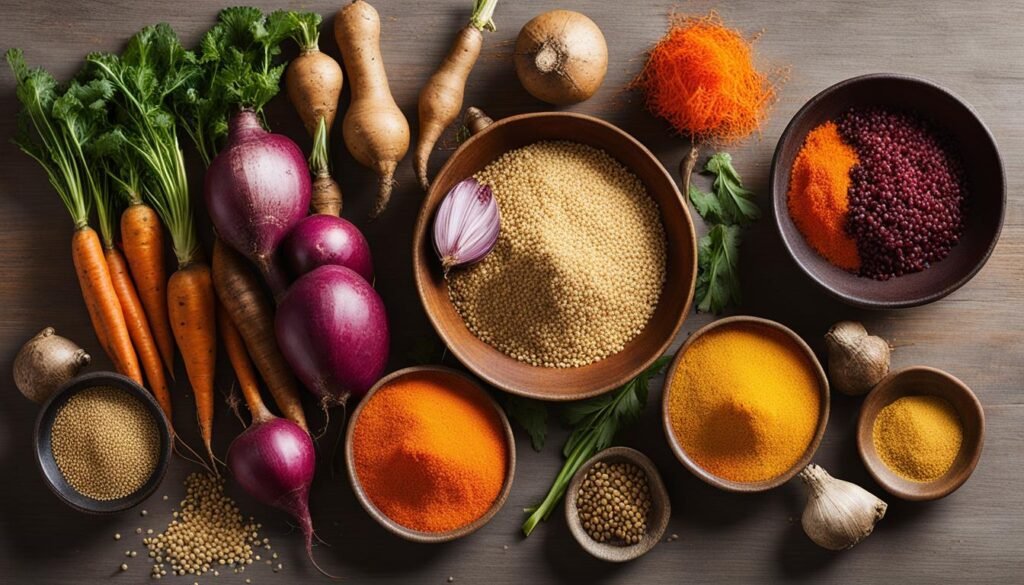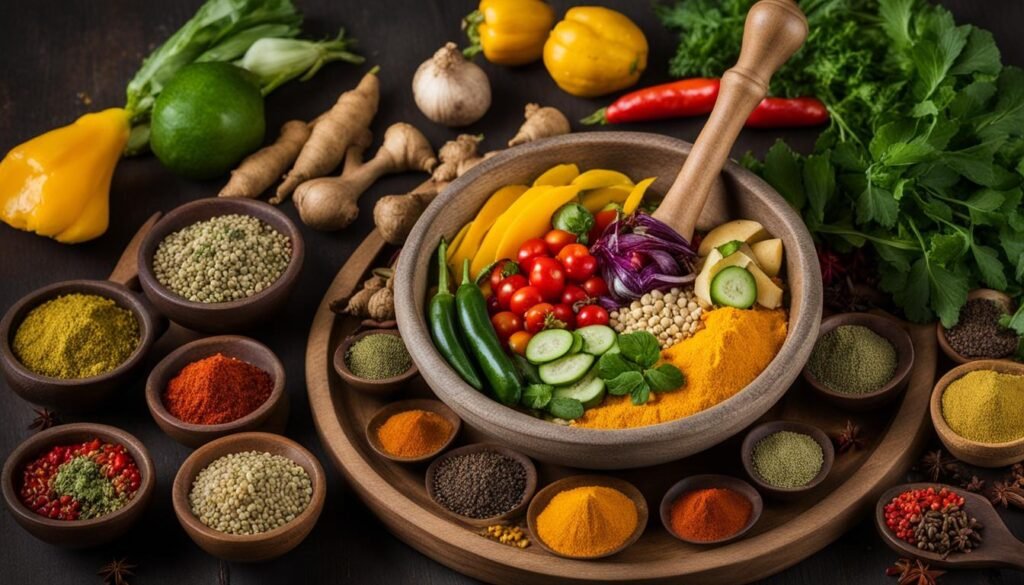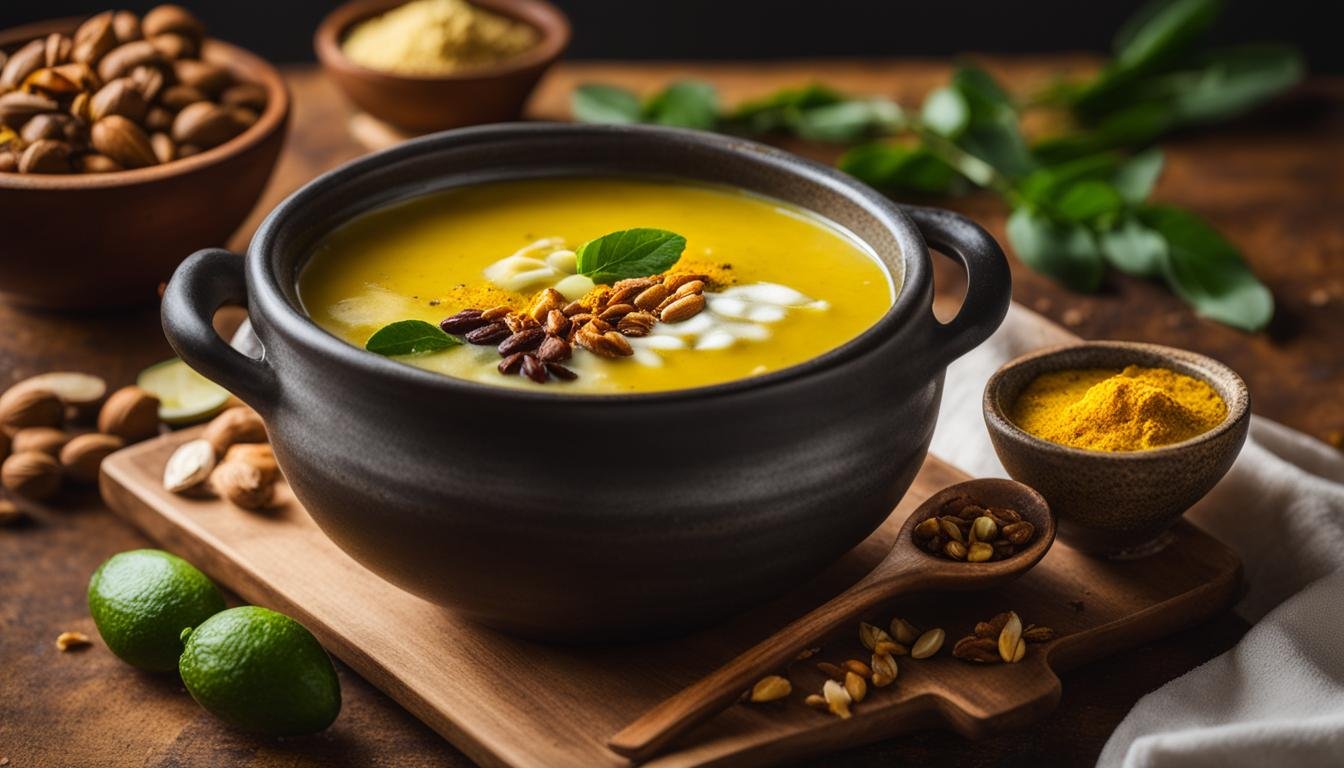According to Ayurveda, the Vata dosha, which is associated with the air and space elements, tends to increase during the fall and winter seasons. To balance Vata and maintain optimal health, it is important to follow a Vata-pacifying diet. This section will explore nourishing Ayurvedic Vata recipes that can help balance your body and soothe your soul.
Table of Contents
Key Takeaways:
- Ayurvedic Vata recipes provide nourishment and help balance the Vata dosha.
- These recipes are particularly beneficial during the fall and winter seasons.
- A Vata-pacifying diet consists of warm and cooked foods.
- Incorporating Vata-reducing spices and healthy fats promotes Vata balance.
- Establishing a regular eating routine and adapting to seasonal changes is essential for maintaining Vata balance.
Understanding the Vata Dosha and its Impact on the Body
The Vata dosha plays a crucial role in governing all movement in the body. It comprises the air and space elements and is dominant during the fall and winter seasons. When Vata becomes imbalanced, it can disrupt the harmonious functioning of our body systems, leading to various discomforts. It is important to recognize the signs of aggravated Vata so that we can take proactive measures to restore balance and well-being.
Some common signs of aggravated Vata include:
- Irregular digestion and gastrointestinal issues
- Restlessness, anxiety, and difficulty sleeping
- Joint pain, stiffness, and muscle aches
- Dry skin, brittle nails, and hair loss
- Fatigue, lack of focus, and difficulty concentrating
By understanding these signs and symptoms, we can identify potential imbalances in our Vata dosha and take appropriate steps to restore harmony.
Embracing a Vata-balancing lifestyle and diet can help pacify the aggravated Vata, nourish the body, and promote overall well-being.
Proper nutrition, regular exercise, stress management, and a supportive daily routine are key factors in maintaining Vata balance. It is important to incorporate Vata-pacifying foods, herbs, and lifestyle practices into our daily lives to overcome the imbalances and restore optimal health.
Supporting Vata Balance with Nourishing Ayurvedic Practices
Along with a Vata-balancing diet, Ayurveda offers other practices to support Vata balance:
- Abhyanga – Regular self-massage with warm sesame oil to nourish the body and calm the nervous system.
- Deep breathing – Practicing deep, slow breathing techniques like pranayama to release stress and increase oxygen flow.
- Yoga – Engaging in gentle, grounding yoga poses that promote stability and focus.
- Meditation – Cultivating a regular meditation practice to calm the mind and restore inner balance.
By implementing these Ayurvedic practices along with a Vata-balancing diet, we can restore and maintain equilibrium in the Vata dosha, enhancing our overall well-being.
Vata-Balancing Foods
| Category | Foods |
|---|---|
| Ghee and Oils | Ghee, coconut oil, sesame oil |
| Grains | Rice, quinoa, oats, barley |
| Legumes | Mung beans, lentils, chickpeas |
| Fruits | Bananas, oranges, dates |
| Vegetables | Sweet potatoes, carrots, beets |
| Herbs and Spices | Ginger, cumin, cardamom, cinnamon |
These foods are considered nourishing and grounding, helping to balance the qualities of Vata dosha and restore harmony in the body.
Cooking with Vata-Balancing Foods
To pacify Vata, it is important to focus on consuming warm and cooked foods. Incorporating Vata-balancing ingredients into your meals can help bring balance to your body and mind. Some of the best Vata-balancing foods include:
- Nourishing soups: Warm and comforting soups made with vegetables, lentils, or grains can provide grounding energy and soothing nourishment.
- Hot cereals: Start your day with a warm bowl of oatmeal or quinoa porridge to provide stability and promote digestion.
- Hearty grains: Opt for cooked grains like brown rice, quinoa, or millet to provide sustained energy and grounding qualities.
- Wholesome beverages: Sip on herbal teas, warm water with lemon, or spiced almond milk to stay hydrated and maintain balance.
In addition to incorporating Vata-balancing foods, it is essential to use Vata-reducing spices in your cooking. These spices can help calm the Vata dosha and enhance the flavour of your dishes. Some Vata-reducing spices to include in your meals are:
- Cardamom: Known for its warming properties, cardamom aids digestion and adds a unique flavour to your dishes.
- Cinnamon: This sweet and warming spice helps balance Vata and adds depth to both sweet and savoury preparations.
- Ginger: With its potent anti-inflammatory properties, ginger aids digestion, reduces Vata imbalance, and adds a zing of flavour to your meals.
“Cooking with Vata-balancing foods and incorporating Vata-reducing spices can help soothe the restless energy of Vata and bring harmony to your body and mind.”

By focusing on warm, cooked foods and incorporating Vata-reducing spices, you can create nourishing meals that promote Vata balance and support your overall well-being.
Choosing Vata-Friendly Fruits and Vegetables
When it comes to balancing Vata dosha, incorporating the right fruits and vegetables into your diet can make a significant difference. Here are some Vata-friendly options to add to your meals:
Fruits for Vata Dosha
For Vata dosha, it is recommended to consume sweet and sour fruits that provide nourishment and help balance the dry qualities of Vata. Some excellent choices include:
- Oranges
- Bananas
- Grapes
These fruits not only add vibrant colors to your plate but also offer essential vitamins and minerals that support overall well-being.
Cooked Vegetables for Vata
When it comes to vegetables, it is important to choose cooked options as they are easier to digest and help pacify Vata dosha. Consider incorporating the following cooked vegetables into your meals:
- Beets
- Carrots
- Sweet potatoes
These vegetables not only provide warmth to the body but also offer an array of nutrients that can help nourish and balance Vata dosha.
Vata-Pacifying Spices
To enhance the flavour of your Vata-balancing meals, adding Vata-pacifying spices can work wonders. Consider incorporating the following spices into your dishes:
- Cardamom
- Cumin
- Ginger
These spices not only add a delightful aroma but also possess Vata-balancing properties that can help bring harmony to your body and mind.
Experimenting with these Vata-friendly fruits, vegetables, and spices can help you create delicious and nourishing meals that support Vata balance. Remember to choose organic and high-quality produce for the best results.
| Fruits for Vata Dosha | Cooked Vegetables for Vata | Vata-Pacifying Spices |
|---|---|---|
| Oranges | Beets | Cardamom |
| Bananas | Carrots | Cumin |
| Grapes | Sweet potatoes | Ginger |
Combining these Vata-friendly ingredients in your meals can create a harmonious balance and promote overall well-being. Let these nourishing fruits, vegetables, and spices be your allies in supporting Vata dosha.
Establishing a Regular Eating Routine
A regular eating routine is crucial for maintaining balance and harmony in the Vata dosha. By following a consistent meal schedule, you can support your body’s needs and promote overall well-being.
The Importance of Regular Eating
Regular eating routine plays a significant role in stabilizing Vata dosha. Vata is characterized by irregularity, variability, and movement. By establishing a fixed schedule for meals, you provide a sense of grounding and stability to your body and mind.
Avoid skipping meals or delaying them excessively, as this can aggravate Vata and lead to digestive issues. Instead, aim to have three nourishing meals each day at consistent times.
Vata-Friendly Meal Timings
When it comes to Vata-friendly meal timings, having your largest meal during the middle of the day is beneficial. Noon is considered the ideal time to consume the heaviest meal, as this aligns with the body’s natural digestive fire, known as Agni.
In the Ayurvedic tradition, it is recommended to eat a lighter meal for dinner, allowing the digestive system to wind down as the day comes to an end. This promotes better digestion and quality sleep.
Vata-Pacifying Snacks
In addition to the three main meals, incorporating Vata-pacifying snacks between meals can help maintain a consistent flow of energy throughout the day. These snacks should be light, easily digestible, and nourishing.
Tip: Opt for Vata-pacifying snacks such as a handful of soaked almonds, roasted pumpkin seeds, or a piece of fruit. These snacks provide essential nutrients and help keep hunger at bay between meals.
Sample Vata-Friendly Eating Routine
| Meal | Timing |
|---|---|
| Breakfast | 8:00 AM |
| Morning Snack | 10:30 AM |
| Lunch | 12:30 PM |
| Afternoon Snack | 3:30 PM |
| Dinner | 6:30 PM |

Exploring Vata-Balancing Meal Ideas
Are you looking for delicious meal ideas that can help balance your Vata dosha? Look no further! In this section, I will share a variety of Vata-balancing recipes that are not only nourishing but also packed with flavour. Let’s dive in!
Nourishing Soups
Warm soups are perfect for pacifying Vata. Try a comforting butternut squash soup seasoned with Vata-balancing spices like cardamom and cumin. This creamy and flavourful soup will help soothe your senses and provide essential nutrients.
Hearty Stews
Stews are another great option to balance Vata. Prepare a hearty lentil stew with vegetables like carrots, spinach, and sweet potatoes. Enhance the flavours with Vata-balancing spices like black pepper and ginger. This satisfying dish will keep you grounded and satiated.
Rice Pudding
Indulge in a warm and creamy rice pudding for a Vata-friendly dessert. Cook the rice in almond milk and sweeten it with dates or maple syrup. Add Vata-balancing spices like cinnamon and cardamom to elevate the taste. This dessert will satisfy your sweet tooth while nourishing your body.
| Meal Idea | Ingredients |
|---|---|
| Nourishing Butternut Squash Soup | Butternut squash, vegetable broth, coconut milk, onion, garlic, cardamom, cumin |
| Hearty Lentil Stew | Lentils, carrots, spinach, sweet potatoes, vegetable broth, black pepper, ginger |
| Warm Rice Pudding | Rice, almond milk, dates or maple syrup, cinnamon, cardamom |
Remember to use organic and high-quality ingredients for the best results. Feel free to adjust the recipes according to your taste preferences and dietary needs.
Now that we’ve explored some delicious Vata-balancing meal ideas, let’s move on to the next section and discover more tips for maintaining Vata balance in your diet.
The Importance of Healthy Fats for Vata Balance
To balance the dry and cold qualities of Vata, it is important to incorporate healthy fats into the diet. These fats provide nourishment and help soothe Vata dosha, bringing warmth and stability to the body. By including Vata-balancing oils and fats in your meals, you can support your overall well-being and maintain Vata balance.
There are several oils and fats that are particularly beneficial for Vata dosha:
- Ghee: Known for its warming and grounding qualities, ghee is a key ingredient in Ayurvedic cooking. It helps lubricate the digestive system, promotes healthy digestion, and supports the absorption of nutrients.
- Coconut Oil: A highly nourishing and moisturizing oil, coconut oil is rich in healthy fats and has a warming effect on the body. It helps counterbalance Vata’s dryness, supports healthy skin, and provides energy.
- Sesame Oil: Considered one of the best oils for Vata dosha, sesame oil has a warming and calming effect. It helps alleviate dryness, promotes joint health, and supports overall Vata balance.
By incorporating these oils into your cooking, you can enhance the taste, texture, and overall therapeutic benefits of your meals. These healthy fats not only provide nourishment but also help create a sense of comfort and grounding, which is essential for Vata individuals.

“In Ayurveda, healthy fats are considered essential for maintaining Vata balance. They provide the necessary nourishment, help combat Vata’s dryness, and bring a sense of warmth and stability to the body.” – Ayurvedic Expert
Embracing Vata Balance in Every Season
While Vata is dominant during the fall and winter seasons, it is important to maintain Vata balance throughout the year. Adapting to seasonal changes is key to optimal health and well-being. By understanding the effects of each season on the body and adjusting our diet and lifestyle accordingly, we can support Vata balance and thrive in every season.
Seasonal Vata recipes play a vital role in maintaining balance and harmony within our bodies. As the seasons transition, our dietary needs change, and incorporating Vata-balancing recipes specific to each season can help us adapt and nourish ourselves effectively.
Adapting to the Fall and Winter Seasons
In the fall and winter, Vata tends to increase due to the cold and dry qualities of these seasons. To counterbalance these effects, warm and grounding foods are recommended. Incorporating nourishing soups, stews, and roasted vegetables can provide comfort and stability during this time.
Below is a Vata-balancing recipe idea for the fall and winter season:
Roasted Butternut Squash Soup: Combine roasted butternut squash, carrots, onions, and garlic with vegetable broth. Add warming spices like ginger, cinnamon, and nutmeg for flavour and additional Vata-pacifying benefits. Simmer the ingredients together and blend until smooth. Serve warm and enjoy the nourishing flavours of fall.
Flourishing in the Spring and Summer
As spring and summer bring warmer weather, Vata tends to decrease, but it’s still essential to maintain balance. Lighter and cooling foods become favourable during these seasons. Fresh salads, steamed vegetables, and juicy fruits can help cool and hydrate the body.
Here’s a Vata-balancing recipe idea for the spring and summer season:
Cooling Cucumber Mint Salad: Slice cucumbers and combine them with fresh mint leaves. Add a sprinkle of salt, a drizzle of lemon juice, and a dash of cumin for a refreshing and cooling twist. Serve chilled and savor the crispness of summer.
Adapting to Seasonal Changes for Vata Balance
Adapting to seasonal changes goes beyond just the food we eat. It also involves adjusting our daily routines, self-care practices, and exercise regimens. During the fall and winter, incorporating warming practices like oil massage (abhyanga) and gentle yoga can help ground Vata. In the spring and summer, embracing cooling practices like swimming and staying hydrated can support Vata balance.
| Season | Food Recommendations | Self-Care Tips |
|---|---|---|
| Fall and Winter | Warm and grounding foods Root vegetables and nourishing soups | Abhyanga (oil massage) Gentle yoga and grounding exercises |
| Spring and Summer | Light and cooling foods Fresh salads and juicy fruits | Staying hydrated Engaging in cooling activities like swimming |
By embracing Vata balance in every season, we can align ourselves with the natural rhythms of nature and support our well-being year-round. Whether it’s adapting our diet, incorporating self-care practices, or adjusting our exercise routines, recognizing the unique needs of each season helps us maintain optimal balance and nourishment.
Conclusion
Balancing Vata dosha through a nourishing diet is essential for promoting overall well-being and harmony. Incorporating Ayurvedic principles into your meal plan can help you find balance and enhance your health. By following a Vata-friendly diet that consists of nourishing Vata recipes, you can support your body’s needs and maintain optimal vitality.
Creating an Ayurvedic Vata meal plan involves choosing Vata-balancing foods such as warm soups, hearty grains, and cooked vegetables. It is also important to incorporate Vata-pacifying spices like cardamom, cumin, and ginger that can help restore balance and improve digestion.
In addition to foods, healthy fats play a crucial role in Vata balance. Including oils like ghee, coconut oil, and sesame oil in your cooking can provide nourishment and help soothe Vata dosha. These healthy fats have warming and soothing qualities that support Vata balance and overall well-being.
Embracing the wisdom of Ayurveda and incorporating a Vata diet for balance can have profound effects on your health and vitality. By nurturing and supporting your body with nourishing Vata recipes and a thoughtful meal plan, you can enhance your overall well-being and enjoy a harmonious state of being.
FAQ
What is the Vata dosha?
According to Ayurveda, the Vata dosha is one of the three Ayurvedic body types, or energy forces, that governs all movement in the body. It is associated with the air and space elements and tends to increase during the fall and winter seasons.
What are the signs of aggravated Vata?
Aggravated Vata can manifest in various ways, including digestive issues, fatigue, dry skin, anxiety, and poor assimilation. Recognizing these signs is crucial for maintaining balance and well-being.
What are some Vata-balancing foods?
Vata-balancing foods include nourishing soups, hot cereals, hearty grains, cooked vegetables like beets and sweet potatoes, and sweet and sour fruits like oranges and bananas. Using Vata-reducing spices such as cardamom, cumin, and ginger can also help balance Vata.
Why is establishing a regular eating routine important for Vata balance?
A regular eating routine helps maintain Vata balance by providing consistency to the digestive system. It is recommended to have three nourishing meals a day at consistent times, with the heaviest meal consumed around noon. Eating a lighter meal for dinner and incorporating healthy snacks between meals can further support Vata balance.
What are some Vata-balancing meal ideas?
Some Vata-balancing meal ideas include nourishing soups, stews, and rice pudding. Adding Vata-balancing spices like cardamom, cumin, and black pepper can enhance the flavour of these dishes. Complementing the meals with Vata-pacifying beverages like warm water and Vata Tea can also help maintain Vata balance.
Why are healthy fats important for Vata balance?
Healthy fats, such as ghee, coconut oil, and sesame oil, are important for balancing Vata dosha. They provide nourishment, help soothe the dry and cold qualities of Vata, and support overall well-being.
How can Vata balance be maintained in different seasons?
To maintain Vata balance in different seasons, it is important to adapt to seasonal changes. This can be done by incorporating seasonal Vata-balancing recipes that utilize ingredients aligned with the current season. Adapting to the specific qualities and characteristics of each season helps promote balance and well-being.
How can I create an Ayurvedic Vata meal plan?
Creating an Ayurvedic Vata meal plan involves incorporating nourishing Vata recipes, balancing Vata foods, and following a regular eating routine. By embracing the wisdom of Ayurveda and incorporating Vata-balancing principles, you can create a Vata-friendly meal plan that supports your body’s needs.






Pingback: Soothing Ayurvedic Kapha Recipes For Balance
Pingback: Ayurvedic Beverage Recipes For Holistic Health